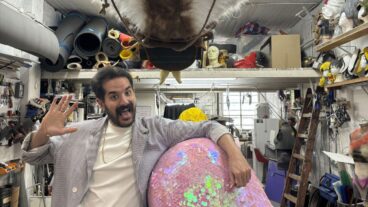The major sale of Israeli art at the prestigious Sotheby’s auction house last month wasn’t just an auction: it was the culmination of a week-long focus on Israeli artists that spanned the city of New York, and celebrated the increasing prominence Israelis have received on the international art scene in recent years.
The celebration of Israeli Contemporary Art Week included an exhibit at the New York Armory Show, the Chelsea Art Museum, the Weil Art, and Midtown’s NEXUS Project Gallery, the Jewish Museum, and various other galleries, as well as music performances at the Manhattan JCC.
It was the second year in a row that the Israeli Foreign Ministry, the Consulate General of Israel in New York, and the Israeli Council of Culture and Art had teamed up to organize the weeklong, citywide celebration of Israeli visual art, that culminated in the Sotheby’s event.
Rivka Saker, a senior Sotheby’s specialist and a prominent figure in the Israeli arts scene, said that the event’s organizers decided to turn it into an annual tradition once they noted the continuing interest and a widened demand for works by today’s Israeli artists manifested at last year’s event.
But none of it would have been justified if the central event, the second annual Israeli art sale at the New York headquarters of Sotheby’s, wasn’t a success.
Happily, that wasn’t a problem. Exceeding all expectations, more than $4 million worth of Israeli works of art was sold — $4,037,100 to be precise.
“The auction showed that Israeli art stands for itself and does not need the assistance of international artists,” auction manager Jennifer Roth told the Hebrew newspaper Yediot Aharonot. “The results will encourage Sotheby’s to continue selling Israeli art in the United States.”
The art that was auctioned and sold spanned the life of the country, from artists who arrived long before the state was declared, to the most contemporary of artists, and included numerous mediums — painting, sculpture and photography.
The star of the show and the modern-day work that received the most attention was a photograph by Adi Nes, one of Israel’s best-known and most respected photographers. His works have appeared in European and American galleries and museums, where they were met with critical acclaim and a great deal of notice by the press. Many of his photographs have become so familiar in Israel that they have all but entered the canon of iconic images.
“It makes me happy that my work gets to these sales,” Nes told ISRAEL21c. “It reflects the faith that collectors have in Israeli art in general, and my work specifically. Obviously, one has to remember that the dollar value of a work of art is not its real measure — it’s artistic value is primary. But I am glad of the sale in that it shows the enjoyment that it brings the audience.”
Nes, who is 38, got his first big international break in 1998, when his works were included in a special exhibition at New York’s Jewish Museum.
This year, the work that everyone had their eye on at the Sotheby’s auction was Nes’s reconstruction of The Last Supper.
His photograph recalls the great painting, only instead of Jesus and his disciples, uniformed soldiers sit at a long table. The soldier who replaces Jesus stares sadly into the distance and seems disconnected from the soldiers around him, who are laughing, their arms draped over one another’s shoulders, lighting each other’s cigarettes and pouring tea from the plastic jugs on the table.
Nes grew up in Kiryat Gat, a development town on Israel’s “periphery.” His photographs are very much informed by issues of identity, of homo-eroticism and masculinity.
Following the exhibition at the Jewish Museum in New York, Nes attracted a great deal of interest in the art world. He went on to several solo exhibitions at prominent galleries in New York, Paris, San Francisco and Tel Aviv, which were given extensive and enthusiastic coverage by the print media, and won a prestigious prize for photography.
Nes’s success is merely a sign of the increased awareness of Israeli art internationally, and in New York in particular, which has been growing in momentum over the past few years.
“Israeli contemporary art in particular is getting more recognition in the art world,” Smadar Sheffi, art critic for Ha’aretz newspaper, told ISRAEL21c. “You see it in international exhibitions. The talent is certainly there, and real efforts have been made beginning in the early ’90’s to export Israeli art.”
She points as a key figure to the video artist Michal Rovner, who was the first non-American artist to have a show at the prestigious Whitney Museum of American Art in 2002.
Rovner moved her primary residence to New York in 1987. Sheffi noted that Israeli artists traveling abroad frequently and those who have moved abroad maintaining their connections to Israel, along with the closer connections between Tel Aviv galleries and their counterparts in Europe and the U.S. have all contributed to the new prominence of Israeli artists.
“We are in a very good period,” she said. “A clear measure of this is the fact that the curator of the most recent Venice Biennial, a major event in the contemporary art world, chose eight Israelis for the main exhibition — a very large number, and they were very conspicuous as a good group of artists.”
That group included installation artist Etti Abergel, sculptor Carmit Gil, painter Avner Ben Gal, video artists Amit Goren and Doron Solomons, photographer Efrat Shvily, sound and light artist Michal Helfman, and installation artist Nahum Tevet.
In addition, Dalia Levin, the director of the Herzliya Museum, served as one of the event’s five jurors — another move that added to Israeli prestige, as well as Rovner’s impressive show in the Israeli national pavilion.
“Israeli artists have been popping up in Europe and the US like mushrooms after the rain,” Tami Katz-Freiman recently told the Jerusalem Post. “Every good Israeli artist who has exhibited abroad has created a buzz, and I predict that exposure abroad will continue to grow.”
In addition to the contemporary work, classic Israeli paintings and sculptures also sold well at Sotheby’s last month. A rare early painting by Reuven Rubin titled “Outskirts of Tel Aviv” painted in 1923, when he first arrived in the country, which evokes the new city rising from the sand dunes among the sea. Rubin and his contemporaries, moving from Europe to the Middle East were fascinated by the warm, bright colors of the Mediterranean and incorporated them into their portrayals of the local figures and landscape. The painting sold for $204,000.
Another notable piece was a painting by Mordechai Ardon, whose work is distinguished by the German influence on Israeli Art. The Polish-born Ardon studied at the Bauhaus school in Weimar under Klee, then Kandinsky and Feininger, before emigrating to Palestine in 1933, where he influenced younger generations of artists as a teacher and then a director of the Bezalel School of Art in Jerusalem. His work reflects the Bauhaus style, combined with symbolism from his Jewish background as well as the mysticism of the Holy Land. His painting, “Patience” sold for $190,000.












